How Much is a 1976 $2 Bill Worth? (Rare Series & Value Guides)
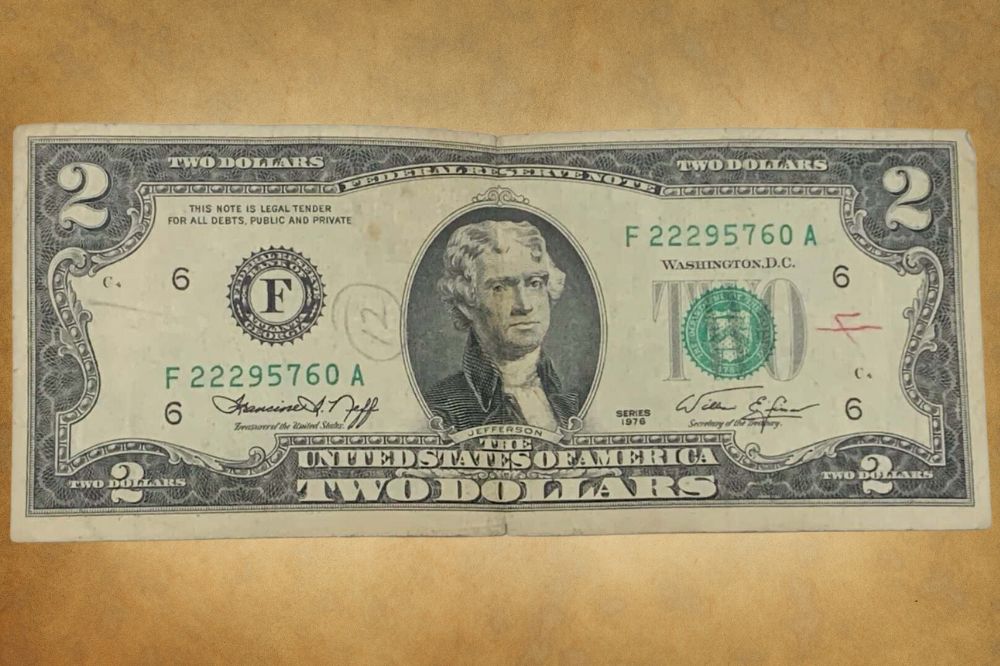
Many Americans believe the 1976 $2 bill value is high because of its rarity. Unfortunately, that is far away from the actual situation. These notes are neither rare nor expensive, and you can buy most for their face value of two dollars.
Only a few rarities and one desirable error can bring you more money than expected. The reason for occasional appearances in circulation is this banknote’s negative reputation. Let’s check all about that mystery.
1976 2 dollar bill value chart |
|||
| Series | Bills in uncirculated condition | Bills in circulated condition | Bills with a star (★) |
| *by the Spruce crafts | |||
| 1976 with a green seal | $5 to $10 | Face value | / |
| *by Oldmoneyprices.com | |||
| 1976 with a green seal | $5 | $2 | $8 |
| *by Love to know | |||
| 1976 with a green seal | $3 | $2 | / |
1976 $2 Value Guides
Two-dollar bills are beautiful and historically important notes, but most Americans avoid using them and preferably choose one-dollar banknotes in their everyday lives.
However, millions of these bills are all around us, and most only cost two dollars though some can be valuable.
1976 $2 bill
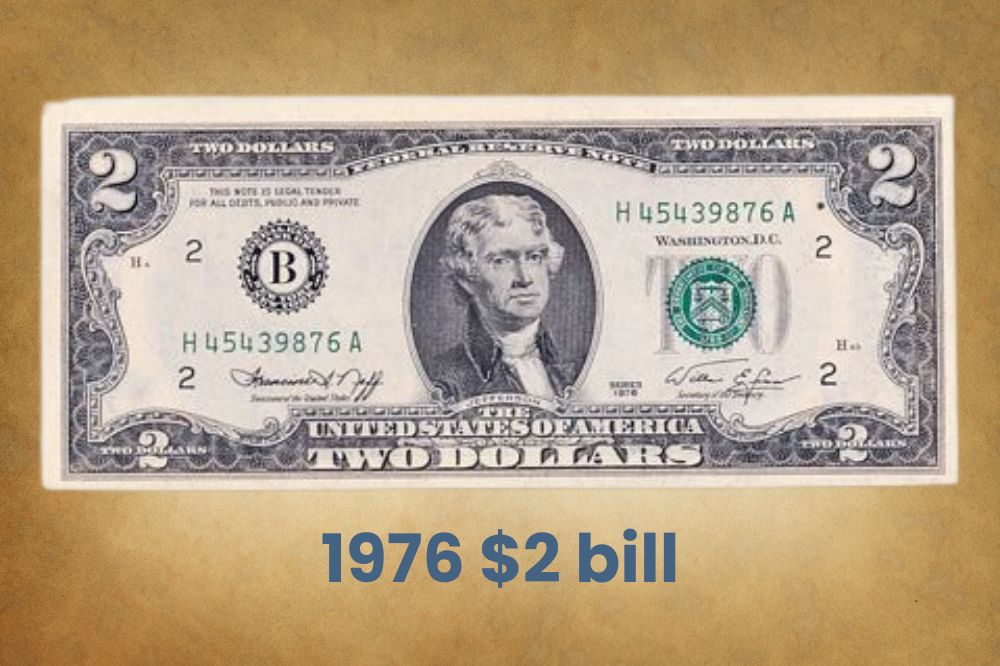
A regularly used 1976 $2 bill is worth about two dollars, or as much as its face value. However, one in an uncirculated condition can cost at least $15.
On the other hand, particular notes with an unusual combination of numbers or changed seals can be pricey. For instance, $2 bills with a star have at least four times the standard value, but rare ones are always worth more.
Interestingly, many people believe that $2 bills are rare since they are uncommon in circulation. The fact is that they are not scarce at all, but people refrain from using them for numerous reasons.
Negative reputation
This banknote got a bad reputation as the Dirty Tom or Whore Note, preventing its wide circulation. Possible reasons were:
- Election rigging included a reward of $2 for a favorable vote, so having such a bill was considered evidence of selling the vote
- Since prostitutes charged their job two dollars in the early 1920s, people avoided this bill as proof that they used such a service
- Winning the gambling tracks brought a prize of $2, so people could assume that only gamblers have this bill in the wallet
- Due to the deuce’s bad reputation, many superstitious people believed the $2 bill was also a bad luck
Nothing could change this bill’s reputation, and its circulation was low from the very beginning. The Federal Reserve solved the usage problem with these banknotes by using them for paying soldiers, commissaries, USOs, and post workers by the 1980s.
Interestingly, no one wants to counterfeit the $2 bill, making it a rare non-redesigned US note. Practically, there is no need for additional protection.
1976 $2 Bill Errors
The $2 bill has only one recognizable error, but you can find a few other uniqueness worth the money. Let’s take a look.
Double serial number
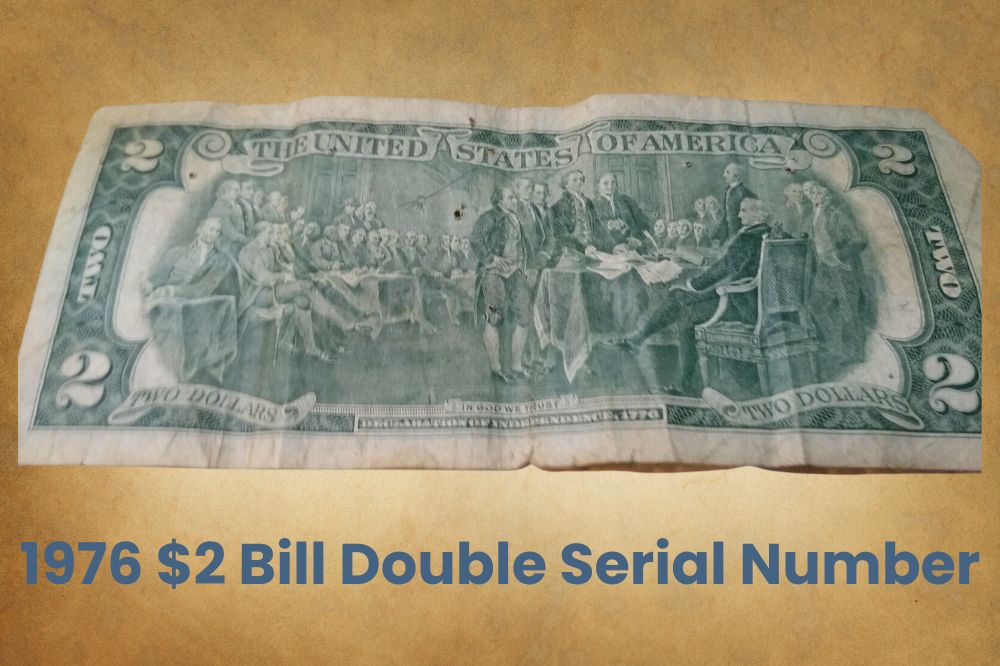
The best-known 1976 $2 error bill has two different serial numbers printed on two places on the obverse. It resulted from a printing error since these serial numbers always match on regular notes. Depending on their condition, these bills typically cost $500 to $900.
Stamped $2 bills
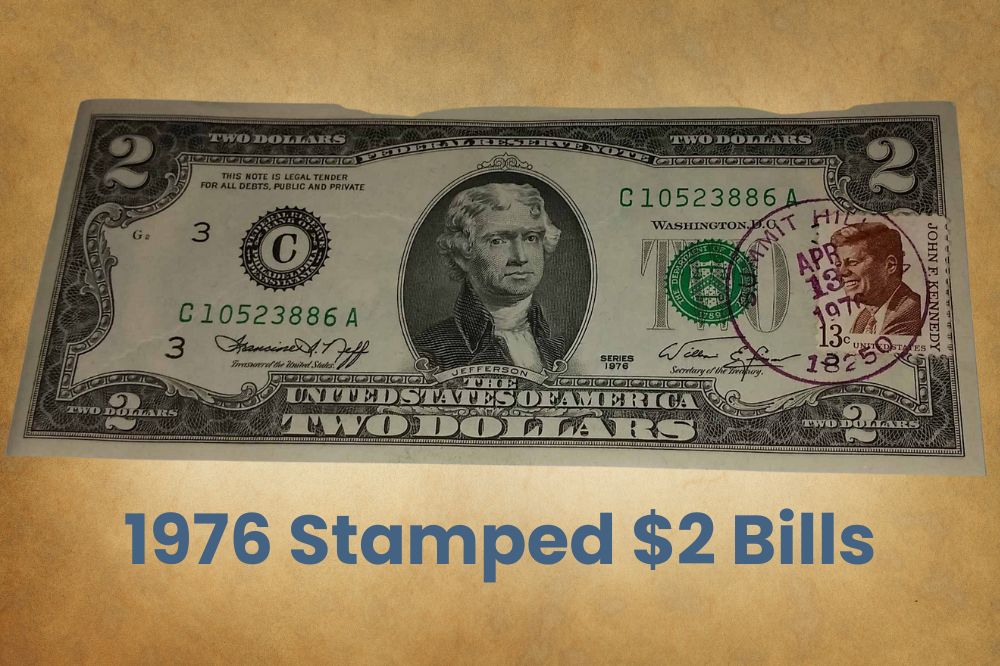
Everyone who got a 1976 $2 bill issued on 13th April 1976 could go to the local post office to get it stamped with the date. These pieces typically cost more than regular notes.
Star notes
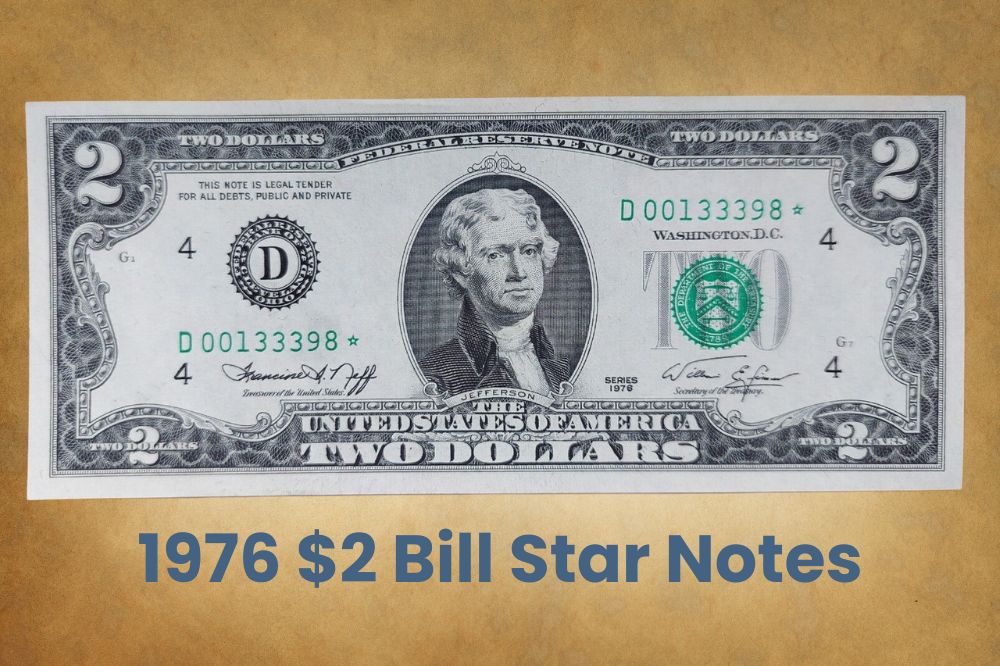
The $2 bills with a star in front of the serial number are replacement notes. Depending on the federal reserve bank that printed them, they can be valuable. You could be sure you have a real gem if your note was printed in Minneapolis or Kansas City.
While common star note varieties in fine condition cost about $8, those in an MS 63 grade are worth $20 to $25. On the other hand, you will get approximately $80 to $150 for rare star note varieties, depending on their condition.
Misprints, palindromes, and repeated numbers
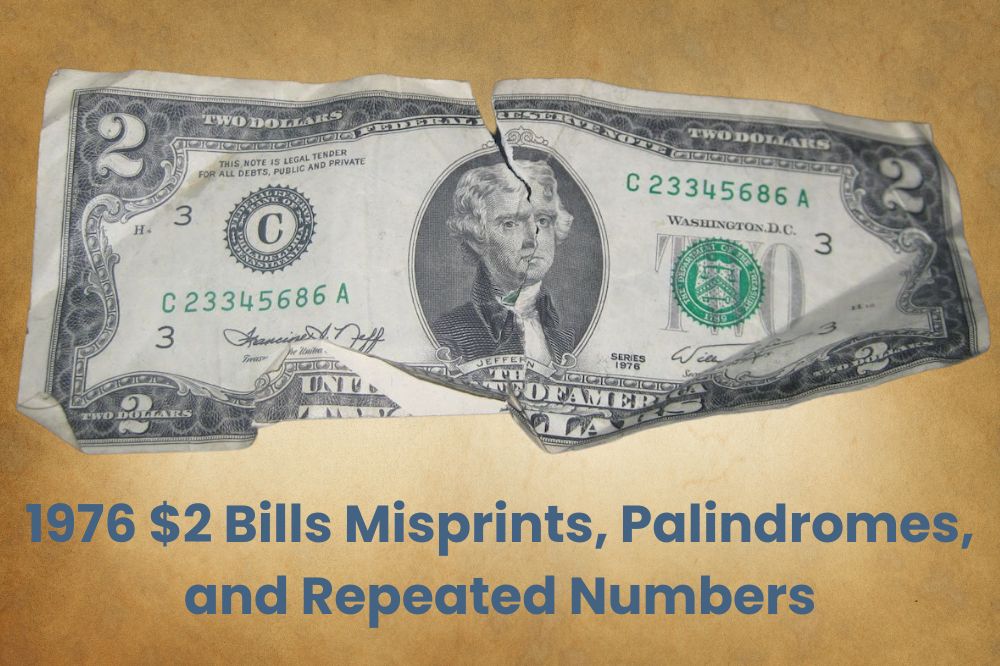
Palindromes or so-called $2 radar notes have the same serial numbers regardless of whether you read them from forward or backward. Only rare notes contain repeated numbers, making them rare and valuable for collectors. Finally, bills with doubled or improperly placed seals can sometimes be pricey.
The $2 ladder bill
The rarest possible two-dollar bill is a genuine ladder with 12345678 number series. Only one out of every 96 million notes has this string of numbers, making them pricey.
A less desirable variation is the one with a reverse ladder, like an 87654321 sequence of numbers, while the less expensive ones are broken ladders. They include numbers in a row interrupted by zeros, like 01200304.
History of the 1976 $2 Bill
Believe it or not, the first $2 bill was a Continental printed on 25th June 1776, making it nine days older than the United States! Two centuries later, 12 Federal reserve banks printed new $2 banknotes (Bicentennial Two) with a green seal.
This controversial paper money was introduced to the public as part of the 200th anniversary of independence. However, it was not the first such a note, and you can find five $2 types existing:
- Legal tenders (red seal)
- Federal Reserve banknotes (green seal)
- National and Federal Reserve banknotes (brown seal)
- Silver certificates (blue seal)
- Gold certificates (orange or gold seal)
The first $2 bill with President Thomas Jefferson on the front page appeared in 1929, and these bills are the oldest of all US notes still in use. However, the back page was changed in 1976 to honor the Declaration of Independence and its signing.
According to the Treasury Department’s Bureau of Engraving and Printing, they produced a total of $2,430,720,000 two-dollar notes from 1976 to 2012. Of these, 590,720,000 bills were made as the 1976 $2 series printed from 1976 to 1979.
The current $2 bill printing depends on demand. Since it is typically low, each series can last for years, so new dates only occur from time to time. If you want to possess or use one of these banknotes, it is enough to visit the first bank on the road and get them by request.
1976 small size $2 bill series |
|||
| Federal reserve bank | Number designation | Letter designation | Production period |
| Boston | 1 | A | March to October 1976 |
| New York | 2 | B | February to October 1976 |
| Philadelphia | 3 | C | February to November 1976 |
| Cleveland | 4 | D | January to September 1976 |
| Richmond | 5 | E | December 1975 to January 1977 |
| Atlanta | 6 | F | January to December 1976 |
| Chicago | 7 | G | January 1976 to August 1979 |
| St. Louis | 8 | H | February 1976 to January 1977 |
| Minneapolis | 9 | I | February 1976 to September 1979 |
| Kansas City | 10 | J | February to October 1976 |
| Dallas | 11 | K | March to November 1976 |
| San Francisco | 12 | L | December 1975 to September 1979 |
Features of the 1976 $2 Bill
In the last two decades, Federal reserve banks have released an average of 2.4 million new $2 bills to circulation monthly. The first pieces appeared in 1976, and it is estimated that about 306,800,000 of these bills and a smaller share of older notes are still in circulation.
The front page of the 1976 $2 dollar bill
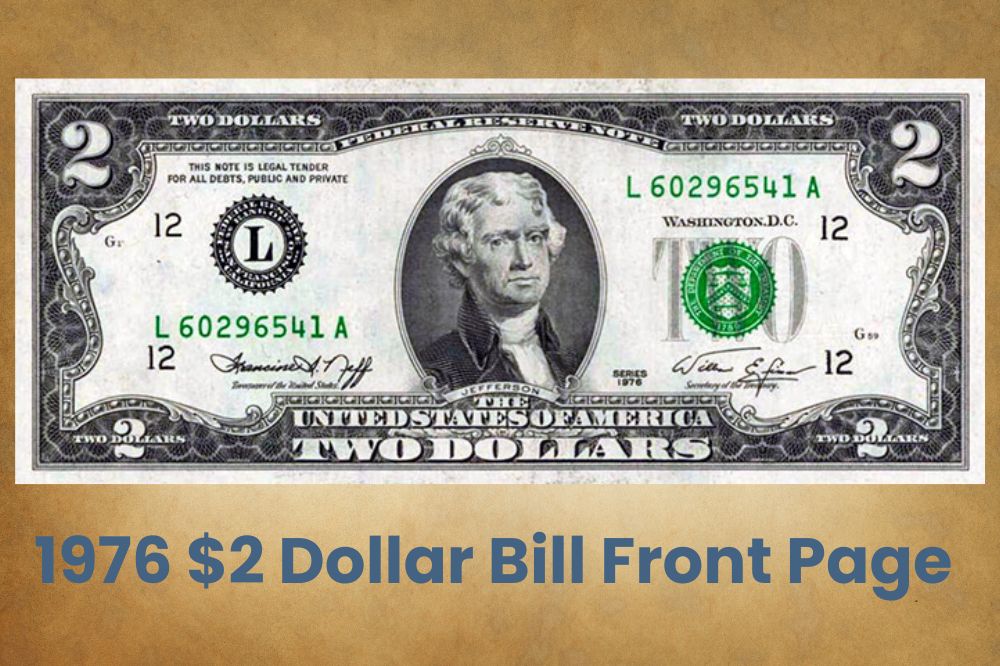
The $2 bills with the same basic obverse as in previous notes produced since 1928 were released on Thomas Jefferson’s birthday in 1976. They had the 3rd President on the front page, along with the green treasury seal and serial numbers. The new seal color replaced the red one, differentiating new bills from the previously issued Legal Tender ones.
The back page of the 1976 $2 bill
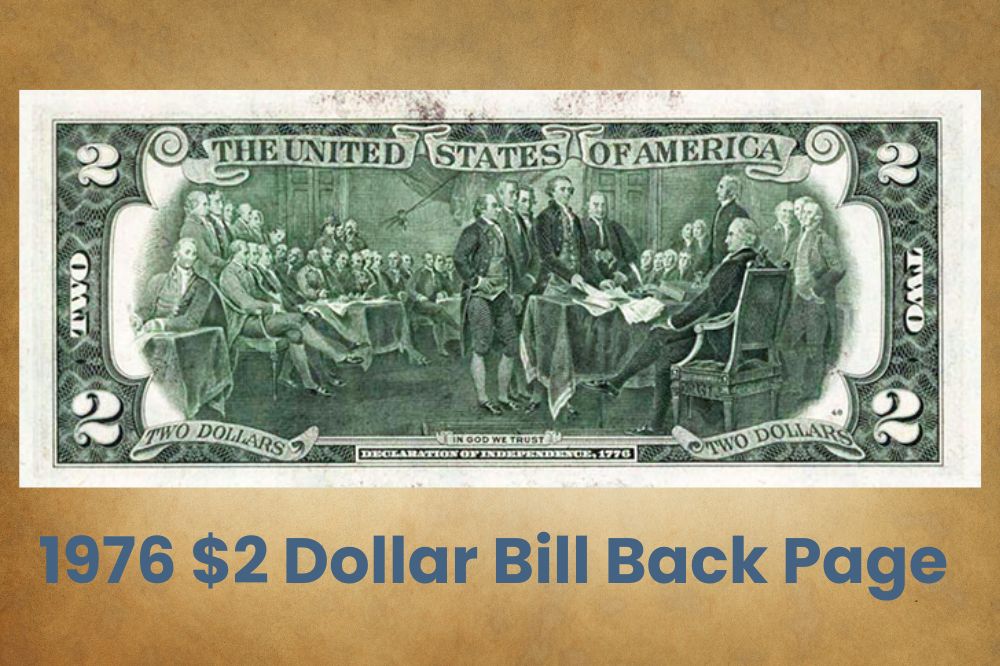
This bill side contains the vignette depicting the moment of signing the Declaration of Independence, based on John Trumbull’s painting. Interestingly, you can see only 42 men on the note, although the original painting includes 47 men. It is the result of the limited space on the note surface.
Unlike established opinion, these notes’ reverse contained a bicentennial-themed design because their release coincided with the Bicentennial. There was no intention to print a unique banknote on the occasion of this celebration as with coinage.
1976 $2 bill |
|
| Face value | $2 |
| Number printed | 590,720,000 |
| Type | Federal Reserve note |
| Producer | The US Bureau of engraving and printing |
| The front page | The 3rd American President, Thomas Jefferson |
| The back page | The signing of the Declaration of Independence |
| Material | 75% cotton and 25% linen |
| Series | One |
| Bill height | 2.60937 inches (66.28 mm) |
| Bill width | 6.14062 inches (156 mm) |
| Bill weight | 0.03527 ounces (1 g) |
| Seal variety | Green |
| Shape | Rectangular |
| Security features | Red and blue security fibers and raised printing |
Other features of the 1976 $2 bill
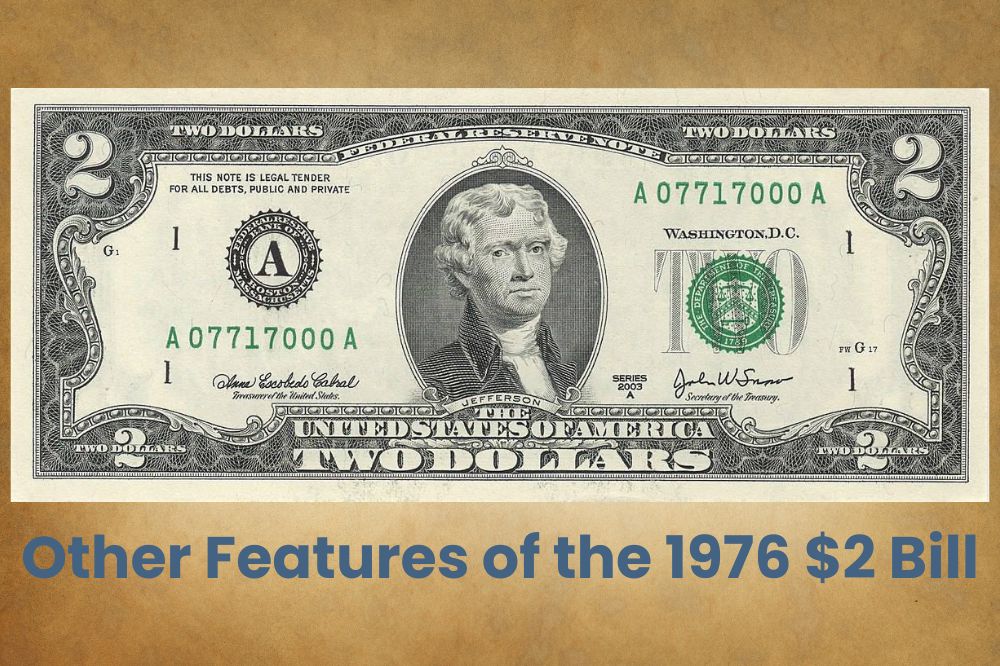
Each 1976 two-dollar bill has a distinctive look, adequate seal, and unique printing, texture, and paper quality.
Portrait and vignette
The 3rd American President Thomas Jefferson’s portrait is on the 1976 $2 bill front page. The back page shows the moment of the Declaration of Independence signing.
Seals
You can see the black Federal Reserve bank seal left of the centrally positioned portrait. It contains the distributing bank’s name and corresponding letter. The green treasury seal on this bill is placed on the portrait’s right side. It also includes an incorporated English inscription.
Serial number
Each note contains a combination of one letter, eight digits, and the second letter and appears twice on the front page. These numbers determine a series year and place of printing.
The first letter is always between A and L and represents one of the twelve Federal Reserve banks that prints the note. You will never see two letters in the serial number:
- The letter O because of its similarity to zero
- The letter Z because it marks test printings
Sometimes, you can see a star appearing instead of the last letter. The existence of this so-called star sheet means it replaced the detected imperfect original sheet that sometimes occurs during the manufacturing process.
Signature
All American banknotes, including the 1976 two-dollar bill, have two signatures on the front page. In the case of those printing this particular year, they belong to:
- Treasury Secretary William Simon
- Treasurer Francine Irving Neff
Printing
The printing on this note’s surface is a bit raised, giving genuine Federal Reserve notes a recognizable texture.
Paper
The 1976 $2 bill is made of paper containing 75% cotton and 25% linen. You can also notice security fibers in red and blue color.
FAQ about the 1976 $2 Bill
Is a 1976 two-dollar bill rare?
The Federal Reserve estimated that about 1.4 billion of $2 bills were made during the production period. However, these notes are still the rarest American currency denomination, with less than 0.001% of all money or 1% of currently produced US notes in circulation.
Even though there is a belief that these notes are rare and people keep them, hoping they are valuable, it is not the case. In fact, low demand is the reason for such a low representation in circulation. Collectors consider only pieces older than 50 years and those with a printing error rare and valuable.
What is the estimated 1976 two-dollar bill value?
A $2 bill in the circulated condition is usually worth its face value. On the other hand, you should get $5 to $10 for those that never spent time in circulation. Finally, you can expect the highest sum for replacement bills with the star or an atypical post office stamp.
Which $2 bill serial numbers are valuable?
Some unusual and rare serial numbers potentially increase a $2 bill value. For instance, numbers like A11111111A or a genuine ladder (12345678) are unique, and collectors will pay more for such bills.
The desirable, so-called radar notes are those with palindromes. They have the same serial numbers whether you read them backward or forward.
Finally, most collectors will consider bills with repeated serial numbers valuable and replacement bills with serial number that includes a star.
Which 1976 two-dollar bill is worth a lot of money?
The most expensive two-dollar banknote produced in 1976 with Thomas Jefferson on the front page is the one with the unique printing error. The $2 bill with the twice-printing serial number is worth $500 to $900, depending on the condition.

I have original 2 dollars bill, series 1976,I see,worth alot off money now? How can I change this and how, we’re in the bank?or auction help me thanks.
I have a proof 1976 $2 bill given to me when I visited New York in 1977. It has been kept in mint condition and never been in circulation. How much might this be worth?
What do you mean”twice printing serial numbers”
The $2 bill with the twice-printing serial number is worth $500 to $900, depending on the condition.
I have a 2 dollar bill with the green seal down so low it is touching the long stroke of the W on the Secretary of Treasury’s signature. The seal also touches the very left edge of the T in TWO. Serial # K 10871931 A
Any thoughts?
Resending Question
Have another question.
I have a 2 dollar bill with the green seal down so low it is touching the long stroke of the W on the Secretary of Treasury’s signature. The seal also touches the very left edge of the T in TWO. Serial # K 10871931 A
Just noticed, the signature on the left is almost touching the serial number.
Any thoughts? Thanks!
I have 3 uncirculated $2, One has the stamp and ink seal on it from the post office(April 13,1976). The other two have consecutive Numbers E 19300938A & E19300939A. Can you tell me the worth of any of these please.
I have 4 uncirculated $2 bills from 1976 in mint condition; serial numbers ending in 5734A and starting with I993, 994 and 995. What might they be worth?